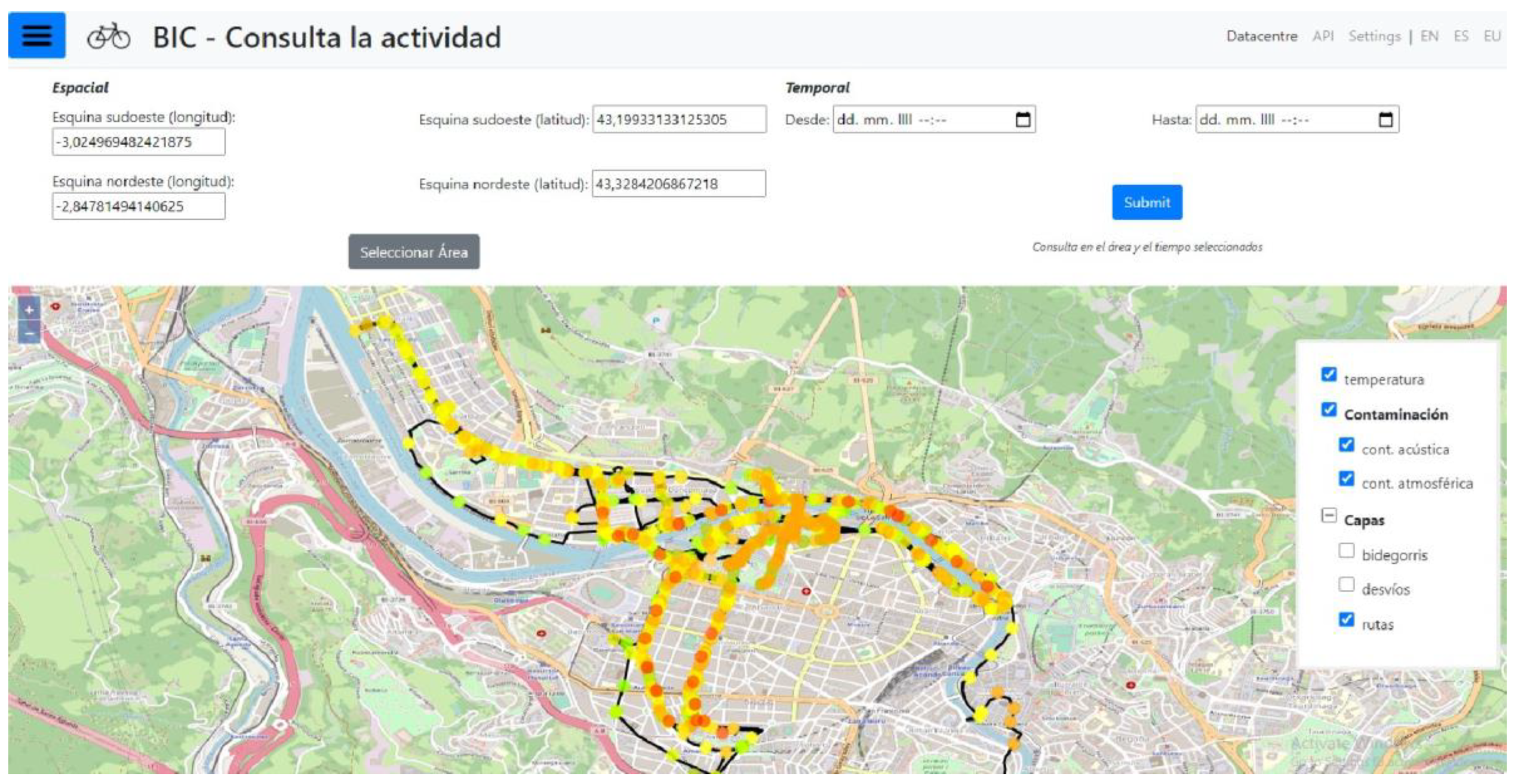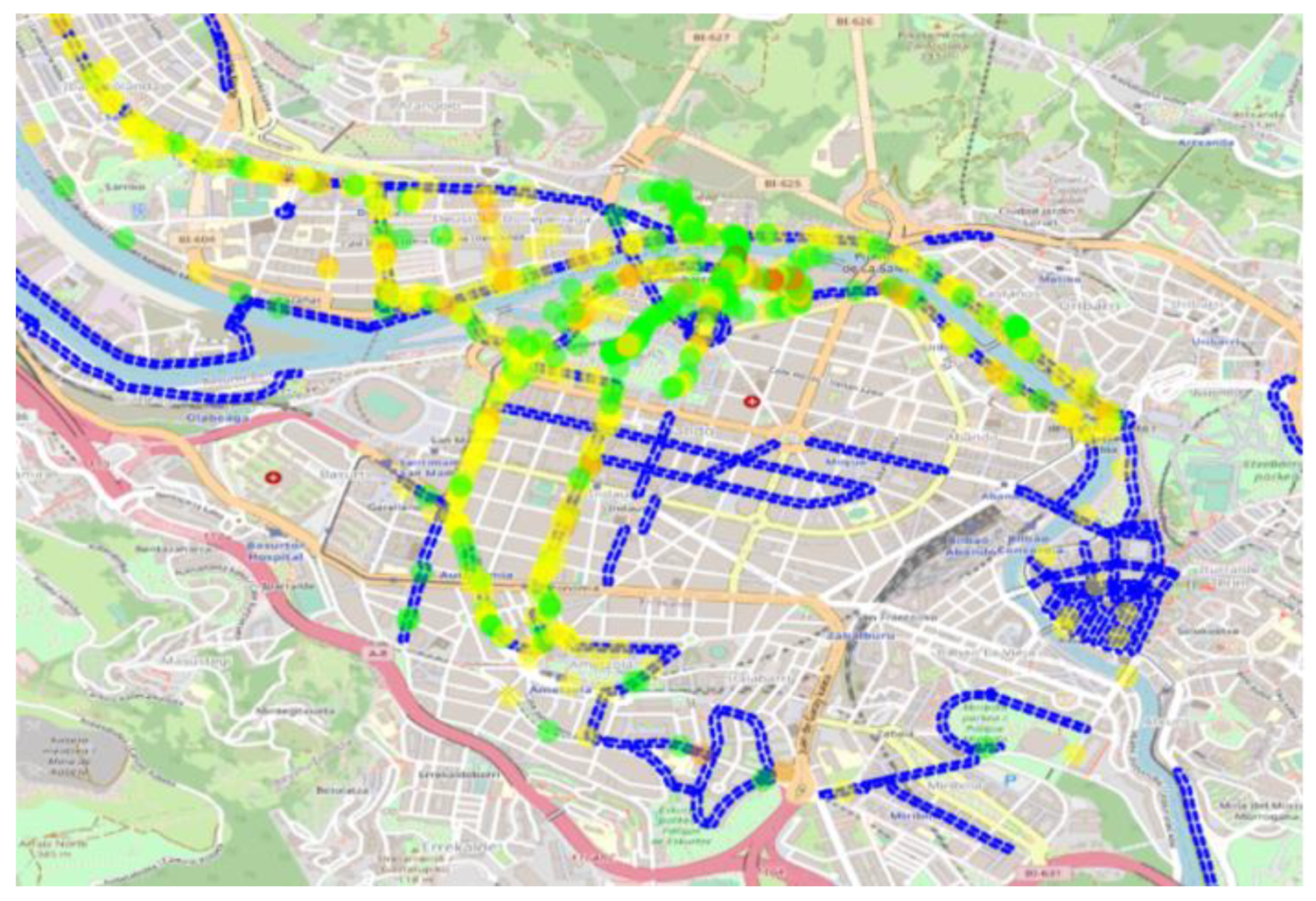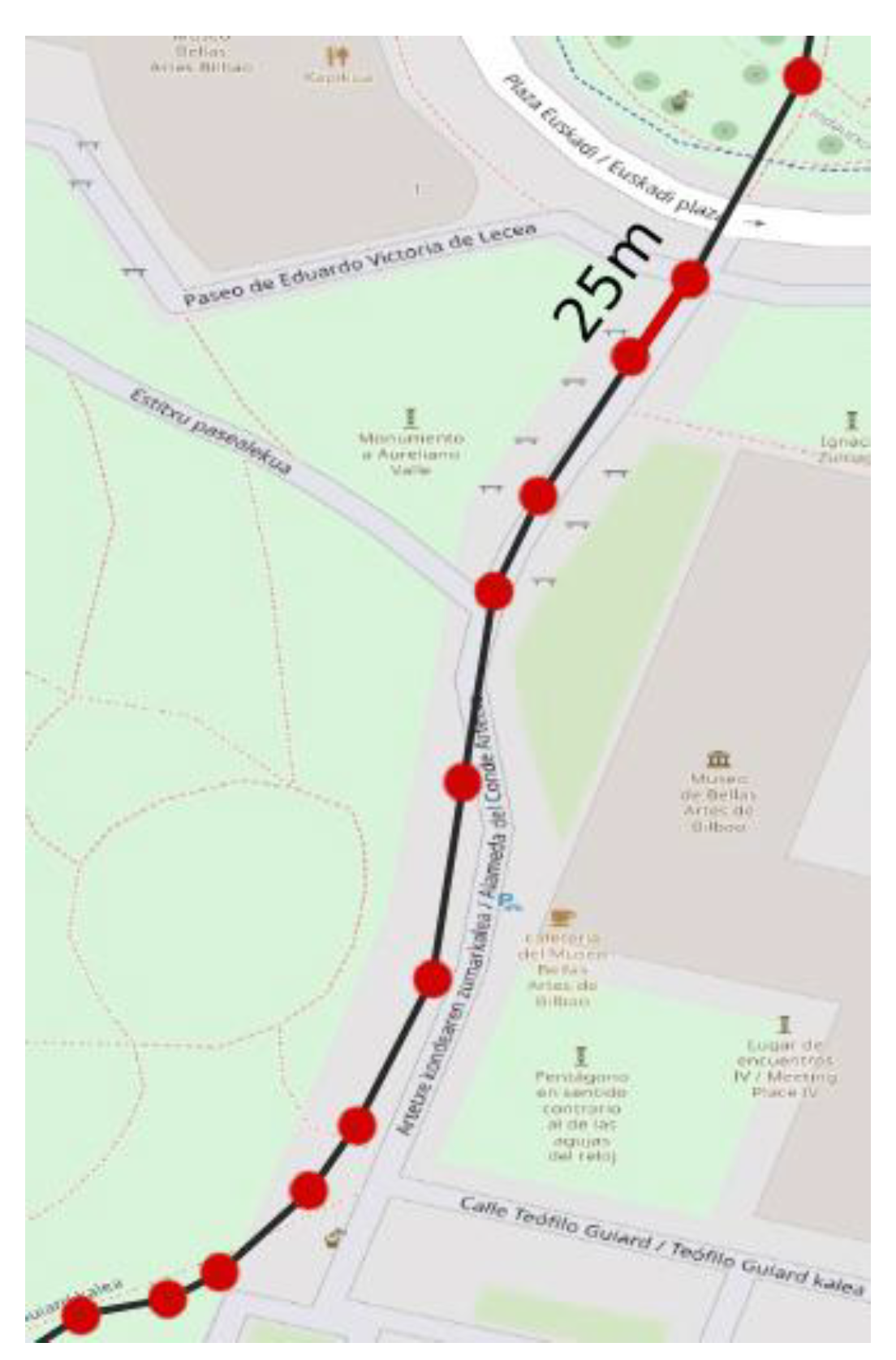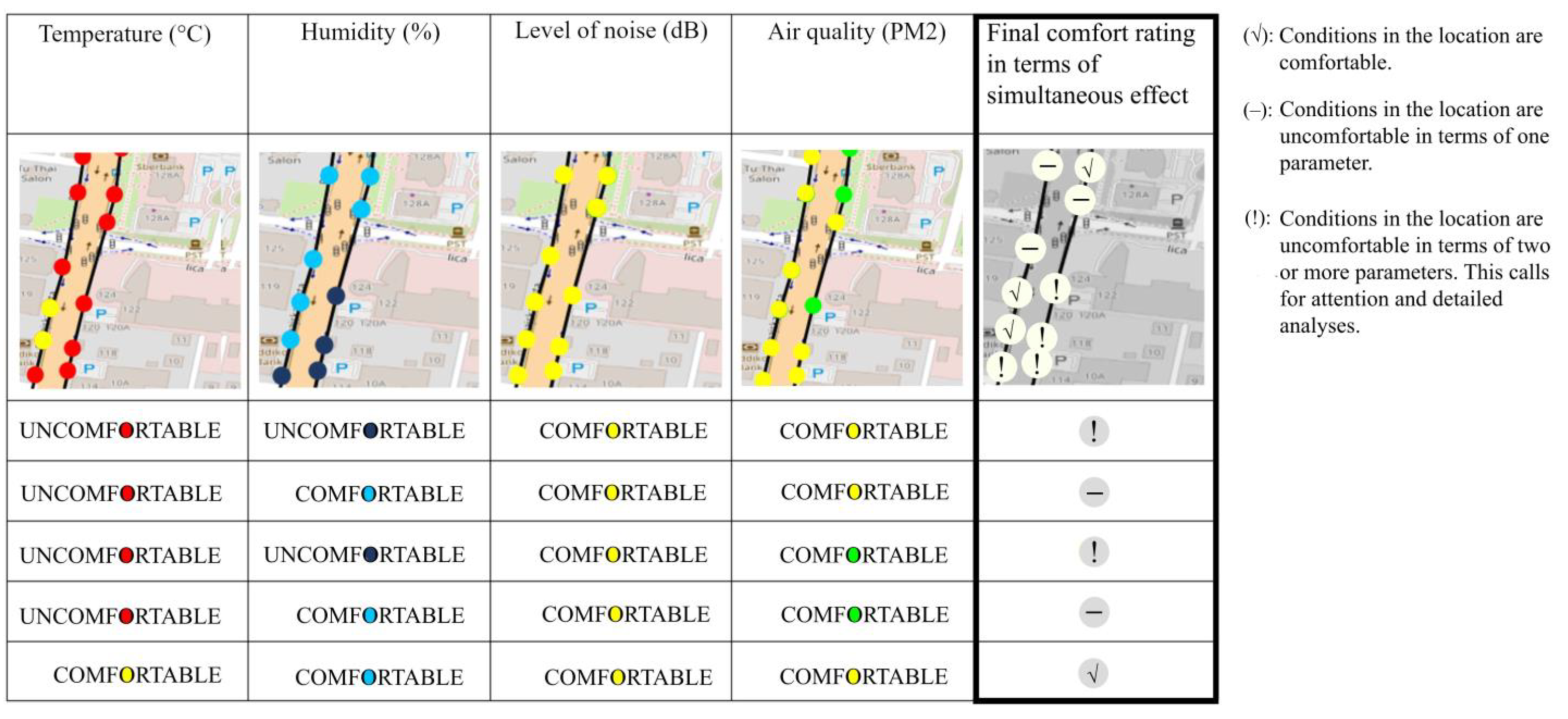A Protocol for Microclimate-Related Street Assessment and the Potential of Detailed Environmental Data for Better Consideration of Microclimatology in Urban Planning
Abstract
:1. Introduction
- The lack of microclimate consideration in urban planning;
- The lack of collaboration and communication between climatologists, urban planners, and decision makers;
- The lack of simultaneous and integrated microclimate parameter analysis in the form of climatological knowledge so that it can be easily integrated and interpreted in urban planning.
2. Background
2.1. Challenges Regarding the Integration of Microclimatological Knowledge into Urban Planning
2.2. Data Interpretation for Better Consideration of Microclimatology and Microclimate-Related Human Comfort in Urban Planning: The Case of Cycling Lanes
2.3. The Most Common Techniques Used to Map Microclimate
2.3.1. Fixed Weather Station Sensors
2.3.2. Remote Sensing Techniques
2.3.3. In Situ Measurements and the Use of Different Transportable Devices
2.4. Hypothesis Development
3. Method
3.1. Data Characteristics for Better Consideration of Microclimatology in the Urban Planning of Cycling Lanes
3.2. Protocol Development and Methodology for Testing
- Designing a step-by-step guide for assessing space in terms of microclimatic comfort to bring the climatology aspects closer to urban design analysis;
- Considering the sampling strategy, to ensure the replicability of the protocol;
- Identifying the necessary equipment; and
- Developing the methodology for protocol testing, so the environmental street assessment can be applied in other cases.
3.2.1. Protocol Development
3.2.2. Methodology for Protocol Testing
3.3. Presentation of the Tool
4. Analyses and Results
4.1. Protocol for Microclimate-Related Street Assessment
4.2. Exploring the Potential of Detailed Environmental Data for Urban Planning
4.2.1. The Data Spatial Resolution of the Tool
4.2.2. The Interpretation of Environmental Conditions through Human Comfort Parameters
4.2.3. Comfort in Places
4.2.4. Potential for Comfort Rating in Terms of Simultaneous and Integrated Analysis of Microclimate-Related Comfort Parameters
4.2.5. The Tool’s Temporal Resolution Data
4.2.6. Mapmaking and Linking Environmental Conditions with Spatial Contexts
5. Study Limitations
6. Discussion
7. Conclusions
Author Contributions
Funding

Institutional Review Board Statement
Informed Consent Statement
Data Availability Statement
Conflicts of Interest
References
- Gehl, J. Life between Buildings, 6th ed.; Island Press: Washington, DC, USA, 2011. [Google Scholar]
- Lin, T. Thermal perception, adaptation and attendance in a public square in hot and humid regions. Build. Environ. 2009, 44, 2017–2026. [Google Scholar] [CrossRef]
- Thorsson, S.; Lindqvist, M.; Lindqvist, S. Thermal bioclimatic conditions and patterns of behaviour in an urban park in Göteborg, Sweden. Int. J. Biometeorol. 2004, 48, 149–156. [Google Scholar] [CrossRef] [PubMed]
- Aram, F.; Higueras García, E.; Solgi, E.; Mansournia, S. Urban green space cooling effect in cities. Heliyon 2019, 5, e01339. [Google Scholar] [CrossRef] [PubMed]
- Ghosh, S.; Kumar, D.; Kumari, R. Assessing spatiotemporal variations in land surface temperature and SUHI intensity with a cloud-based computational system over five major cities of India. Sustain. Cities Soc. 2022, 85, 104060. [Google Scholar] [CrossRef]
- Reis, C.; Lopes, A. Evaluating the cooling potential of urban green spaces to tackle urban climate change in Lisbon. Sustainability 2019, 11, 2480. [Google Scholar] [CrossRef]
- Du, T.; Jansen, S.; Turrin, M.; van den Dobbelsteen, A. Effects of Architectural Space Layouts on Energy Performance: A Review. Sustainability 2020, 12, 1829. [Google Scholar] [CrossRef]
- Ragheb, A.A.; El-Darwish, I.I.; Ahmed, S. Microclimate and human comfort considerations in planning a historic urban quarter. Int. J. Sustain. Built Environ. 2016, 5, 156–167. [Google Scholar] [CrossRef]
- Mahmoud, H.; Ghanem, H.; Sodoudi, S. Urban geometry as an adaptation strategy to improve the outdoor thermal performance in hot arid regions: Aswan University as a case study. Sustain. Cities Soc. 2021, 71, 102965. [Google Scholar] [CrossRef]
- EC—European Commission. Evaluating the Impact of Nature-Based Solutions: A Handbook for Practitioners; The Publications Office of the European Union: Luxembourg, 2021; Available online: https://data.europa.eu/doi/10.2777/244577 (accessed on 9 November 2021).
- Dumitru, A.; Frantzeskaki, N.; Collier, M. Identifying principles for the design of robust impact evaluation frameworks for nature-based solutions in cities. Environ. Sci. Policy 2020, 112, 107–116. [Google Scholar] [CrossRef]
- Goličnik Marušić, B.; Dremel, M.; Ravnikar, Ž. A frame of understanding to better link nature-based solutions and urban planning. Environ. Sci. Policy 2023, 146, 47–56. [Google Scholar] [CrossRef]
- Mosca, F.; Dotti Sani, G.M.; Giachetta, A.; Perini, K. Nature-based solutions: Thermal comfort improvement and psychological wellbeing, a case study in Genoa, Italy. Sustainability 2021, 13, 1638. [Google Scholar] [CrossRef]
- Bherwani, H.; Singh, A.; Kumar, R. Assessment methods of urban microclimate and its parameters: A critical review to take the research from lab to land. Urban Clim. 2020, 34, 100690. [Google Scholar] [CrossRef]
- Eliasson, I. The use of climate knowledge in urban planning. Landsc. Urban Plan. 2000, 48, 31–44. [Google Scholar] [CrossRef]
- Lenzholzer, S.; Carsjens, G.-J.; Brown, R.D.; Tavares, S.; Vanos, J.; Kim, Y.; Lee, K. Awareness of urban climate adaptation strategies—An international overview. Urban Clim. 2020, 34, 100705. [Google Scholar] [CrossRef]
- Smid, M.; Costa, A.C. Climate projections and downscaling techniques: A discussion for impact studies in urban systems. Int. J. Urban Sci. 2018, 22, 277–307. [Google Scholar] [CrossRef]
- Jänicke, B.; Milošević, D.; Manavvi, S. Review of user-friendly models to improve the urban micro-climate. Atmosphere 2021, 12, 1291. [Google Scholar] [CrossRef]
- European Environmental Agency (EEA). Urban Adaptation to Climate Change in Europe 2016—Transforming Cities in a Changing Climate; EA Report No. 12/2016; European Environmental Agency: Copenhagen, Denmark, 2016; Available online: https://www.eea.europa.eu/publications/urban-adaptation-2016 (accessed on 9 November 2021).
- Stewart, I.D.; Oke, T.R. Local climate zones for urban temperature studies. Bull. Am. Meteorol. Soc. 2012, 93, 1879–1900. [Google Scholar] [CrossRef]
- Yang, L.; Zhang, L.; Stettler, M.E.; Sukitpaneeni, M.; Xiao, D.; van Dam, K.H. Supporting an integrated transportation infrastructure and public space design: A coupled simulation method for evaluating traffic pollution and microclimate. Sustain. Cities Soc. 2020, 52, 101796. [Google Scholar] [CrossRef]
- Wong, N.H.; Jusuf, S.K.; Tan, C.L. Integrated urban microclimate assessment method as a sustainable urban development and urban design tool. Landsc. Urban Plan. 2011, 100, 386–389. [Google Scholar] [CrossRef]
- Gehl, J. Cities for People; Island Press: Washington, DC, USA, 2010. [Google Scholar]
- Mills, G. Progress toward sustainable settlements: A role for urban climatology. Theor. Appl. Climatol. 2006, 84, 69. [Google Scholar] [CrossRef]
- Barry, R.G. A framework for climatological research with particular reference to scale concepts. Trans. Inst. Br. Geogr. 1970, 49, 61. [Google Scholar] [CrossRef]
- Lin, J.; Brown, R.D. Integrating microclimate into landscape architecture for outdoor thermal comfort: A systematic review. Land 2021, 10, 196. [Google Scholar] [CrossRef]
- Lagouvardos, K.; Kotroni, V.; Bezes, A.; Koletsis, I.; Kopania, T.; Lykoudis, S.; Mazarakis, N.; Papagiannaki, K.; Vougioukas, S. The automatic weather stations NOANN network of the National Observatory of Athens: Operation and database. Geosci. Data J. 2017, 4, 4–16. [Google Scholar] [CrossRef]
- Hammerberg, K.; Brousse, O.; Martilli, A.; Mahdavi, A. Implications of employing detailed urban canopy parameters for mesoscale climate modelling: A comparison between WUDAPT and GIS databases over Vienna, Austria. Int. J. Climatol. 2018, 38, e1241–e1257. [Google Scholar] [CrossRef]
- Pioppi, B.; Pisello, A.L.; Ramamurthy, P. Wearable sensing techniques to understand pedestrian-level outdoor microclimate affecting heat related risk in urban parks. Solar Energy 2022, 242, 397–412. [Google Scholar] [CrossRef]
- Ampatzidis, P.; Kershaw, T. A review of the impact of blue space on the urban microclimate. Sci. Total Environ. 2020, 730, 139068. [Google Scholar] [CrossRef]
- Lembrechts, J.J.; Nijs, I.; Lenoir, J. Incorporating microclimate into species distribution models. Ecography 2019, 42, 1267–1279. [Google Scholar] [CrossRef]
- Read, J.M.; Torrado, M. Remote sensing. Int. Encycl. Hum. Geogr. 2009, 335–346. [Google Scholar] [CrossRef]
- Liang, S.; Wang, J. A systematic view of remote sensing. In Advanced Remote Sensing, 2nd ed.; Liang, S., Wang, J., Eds.; Academic Press: Cambridge, MA, USA, 2020; pp. 1–57. [Google Scholar] [CrossRef]
- Sentinel Online. Available online: https://sentinels.copernicus.eu/web/sentinel/missions/sentinel-2/instrument-payload/resolution-and-swath (accessed on 10 April 2023).
- Yadav, N.; Sharma, C. Spatial variations of intra-city urban heat island in megacity Delhi. Sustain. Cities Soc. 2018, 37, 298–306. [Google Scholar] [CrossRef]
- Hu, Z.; Bai, Z.; Yang, Y.; Zheng, Z.; Bian, K.; Song, L. UAV aided aerial-ground IoT for air quality sensing in smart city: Architecture, technologies, and implementation. IEEE Netw. 2019, 33, 14–22. [Google Scholar] [CrossRef]
- Pigliautile, I.; Pisello, A.L. Environmental data clustering analysis through wearable sensing techniques: New bottom-up process aimed to identify intra-urban granular morphologies from pedestrian transects. Build. Environ. 2020, 171, 106641. [Google Scholar] [CrossRef]
- Nakayoshi, M.; Kanda, M.; Shi, R.; de Dear, R. Outdoor thermal physiology along human pathways: A study using a wearable measurement system. Int. J. Biometeorol. 2014, 59, 503–515. [Google Scholar] [CrossRef] [PubMed]
- Ka-Lun Lau, K.; Shi, Y.; Yan-Yung Ng, E. Dynamic response of pedestrian thermal comfort under outdoor transient conditions. Int. J. Biometeorol. 2019, 63, 979–989. [Google Scholar] [CrossRef]
- Zhang, L.; Wei, D.; Hou, Y.; Du, J.; Liu, Z.; Zhang, G.; Shi, L. Outdoor thermal comfort of urban park—A case study. Sustainability 2020, 12, 1961. [Google Scholar] [CrossRef]
- Xu, D.; Zhou, D.; Wang, Y.; Meng, X.; Chen, W.; Yang, Y. Temporal and spatial variations of urban climate and derivation of an urban climate map for Xi’an, China. Sustain. Cities Soc. 2020, 52, 101850. [Google Scholar] [CrossRef]
- Fallast, M.T.; Pansinger, S.; Krebs, G.; Moser, M.; Zobl, A. Systematically retrofitting city streets: Meeting the demands of climate change through multifunctional climate-responsive street gardens. Urbani Izziv 2021, 32, 111–122. [Google Scholar] [CrossRef]
- Frontczak, M.; Wargocki, P. Literature survey on how different factors influence human comfort in indoor environments. Build. Environ. 2011, 46, 922–937. [Google Scholar] [CrossRef]
- Ekici, C. A review of thermal comfort and method of using Fanger’s PMV equation. In Proceedings of the 5th International Symposium on Measurement, Analysis and Modelling of Human Functions, ISHF 2013, Vancouver, BC, Canada, 27–29 June 2013; pp. 61–64. [Google Scholar]
- Elnabawi, M.H.; Hamza, N. Behavioural perspectives of outdoor thermal comfort in urban areas: A critical review. Atmosphere 2020, 11, 51. [Google Scholar] [CrossRef]
- Lam, C.K.C.; Lau, K.K.L. Effect of long-term acclimatization on summer thermal comfort in outdoor spaces: A comparative study between Melbourne and Hong Kong. Undefined 2018, 62, 1311–1324. [Google Scholar] [CrossRef]
- Mamani, T.; Herrera, R.F.; Rivera, M.-L.; Atencio, E. Variables That Affect Thermal Comfort and Its Measuring Instruments: A Systematic Review. Sustainability 2022, 14, 1773. [Google Scholar] [CrossRef]
- Shooshtarian, S.; Rajagopalan, P.; Sagoo, A. A comprehensive review of thermal adaptive strategies in outdoor spaces. Sustain. Cities Soc. 2018, 41, 647–665. [Google Scholar] [CrossRef]
- Stathopoulos, T.; Wu, H.; Zacharias, J. Outdoor human comfort in an urban climate. Build. Environ. 2004, 39, 297–305. [Google Scholar] [CrossRef]
- Boduch, M.; Fincher, W. Standards of Human Comfort, Relative and Absolute. 2009. Available online: https://repositories.lib.utexas.edu/handle/2152/13980 (accessed on 10 April 2023).
- Song, Y.; Mao, F.; Liu, Q. Human comfort in indoor environment: A review on assessment criteria, data collection and data analysis methods. IEEE Access 2019, 7, 119774–119786. [Google Scholar] [CrossRef]
- Morris, K.I.; Chan, A.; Morris, K.J.K.; Ooi, M.C.G.; Oozeer, M.Y.; Abakr, Y.A.; Nadzir, M.S.M.; Mohammed, I.Y.; Al-Qrimli, H.F. Impact of urbanization level on the interactions of urban area, the urban climate, and human thermal comfort. Appl. Geogr. 2017, 79, 50–72. [Google Scholar] [CrossRef]
- Tong, S.; Wong, N.H.; Tan, C.L.; Jusuf, S.K.; Ignatius, M.; Tan, E. Impact of urban morphology on microclimate and thermal comfort in northern China. Sol. Energy 2017, 155, 212–223. [Google Scholar] [CrossRef]
- World Health Organisation (WHO). WHO Global Air Quality Guidelines; WHO: Geneva, Switzerland, 2018. [Google Scholar]
- Kuang, W. Seasonal variation in air temperature and relative humidity on building areas and in green spaces in Beijing, China. Chin. Geogr. Sci. 2020, 30, 75–88. [Google Scholar] [CrossRef]
- Strava. Available online: https//www.strava.com (accessed on 10 April 2023).
- The State Meteorological Agency, Spain (AEMET) (n.d), Maximum and Minimum Temperatures. AEMET. Available online: http://www.aemet.es/en/eltiempo/prediccion/temperaturas?dia=&zona=penyb&img=maxima (accessed on 9 November 2021).
- World Health Organisation (WHO). Environmental Noise Guidelines for the European Region; WHO: Geneva, Switzerland, 2018; Available online: https://www.who.int/europe/publications/i/item/9789289053563 (accessed on 10 April 2022).










| Temperature (°C) | Level of Noise (dB) | Air Quality (PM 2.5) | Humidity (%) | |
|---|---|---|---|---|
| >40 | >100 | 75 | / | |
| 35–40 | 80–100 | 50–75 | < 15 | |
| 25–35 | 70–80 | 25–50 | 15–30 | |
| 15–25 | 60–70 | 20–25 | 30–45 | |
| / | 40–60 | 10–20 | / | |
| 5–15 | / | / | 40–60 | |
| 0–5 | / | / | 60–90 | |
| <0 | <40 | <10 | / |
Disclaimer/Publisher’s Note: The statements, opinions and data contained in all publications are solely those of the individual author(s) and contributor(s) and not of MDPI and/or the editor(s). MDPI and/or the editor(s) disclaim responsibility for any injury to people or property resulting from any ideas, methods, instructions or products referred to in the content. |
© 2023 by the authors. Licensee MDPI, Basel, Switzerland. This article is an open access article distributed under the terms and conditions of the Creative Commons Attribution (CC BY) license (https://creativecommons.org/licenses/by/4.0/).
Share and Cite
Ravnikar, Ž.; Bahillo, A.; Goličnik Marušić, B. A Protocol for Microclimate-Related Street Assessment and the Potential of Detailed Environmental Data for Better Consideration of Microclimatology in Urban Planning. Sustainability 2023, 15, 8236. https://doi.org/10.3390/su15108236
Ravnikar Ž, Bahillo A, Goličnik Marušić B. A Protocol for Microclimate-Related Street Assessment and the Potential of Detailed Environmental Data for Better Consideration of Microclimatology in Urban Planning. Sustainability. 2023; 15(10):8236. https://doi.org/10.3390/su15108236
Chicago/Turabian StyleRavnikar, Živa, Alfonso Bahillo, and Barbara Goličnik Marušić. 2023. "A Protocol for Microclimate-Related Street Assessment and the Potential of Detailed Environmental Data for Better Consideration of Microclimatology in Urban Planning" Sustainability 15, no. 10: 8236. https://doi.org/10.3390/su15108236






